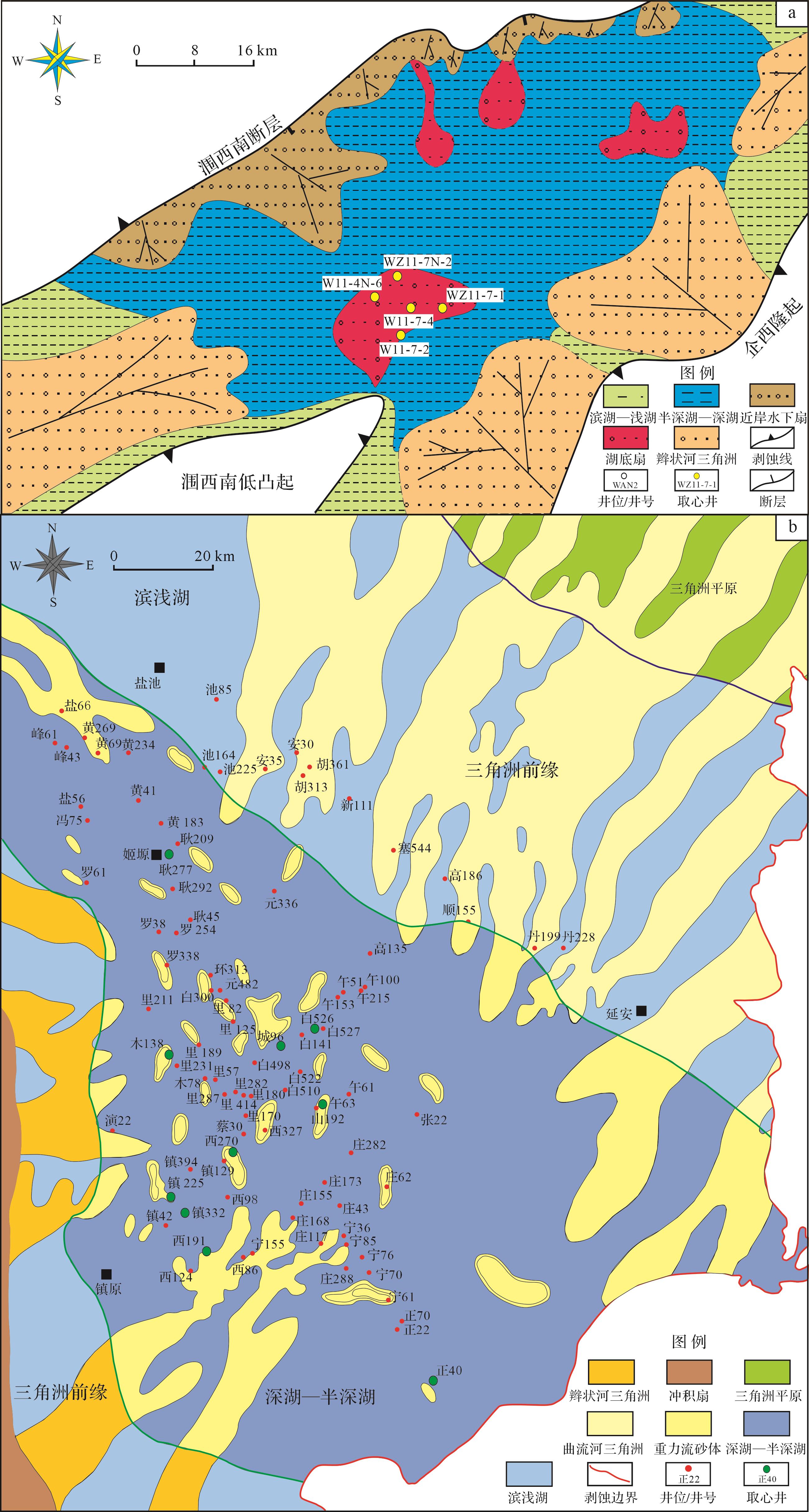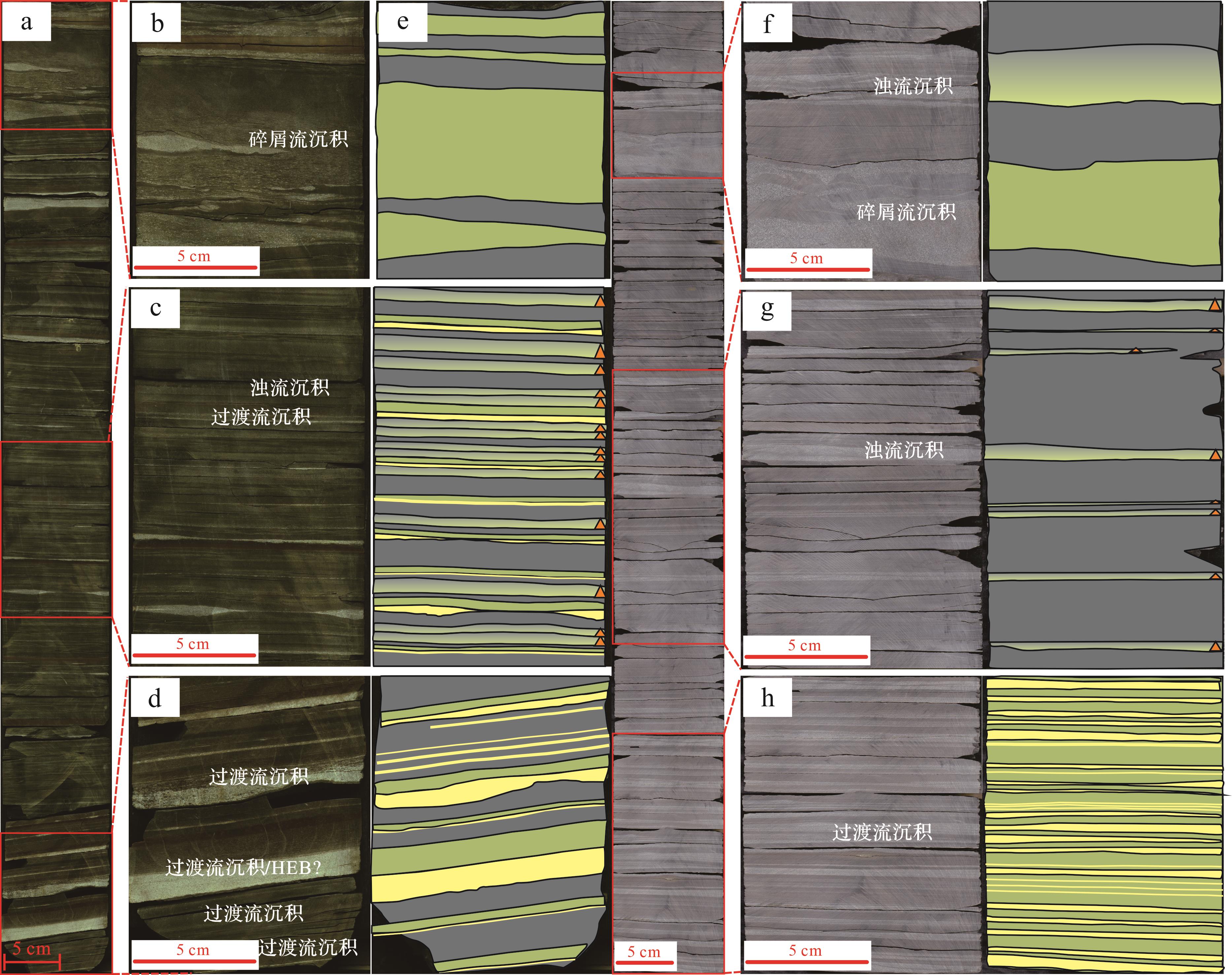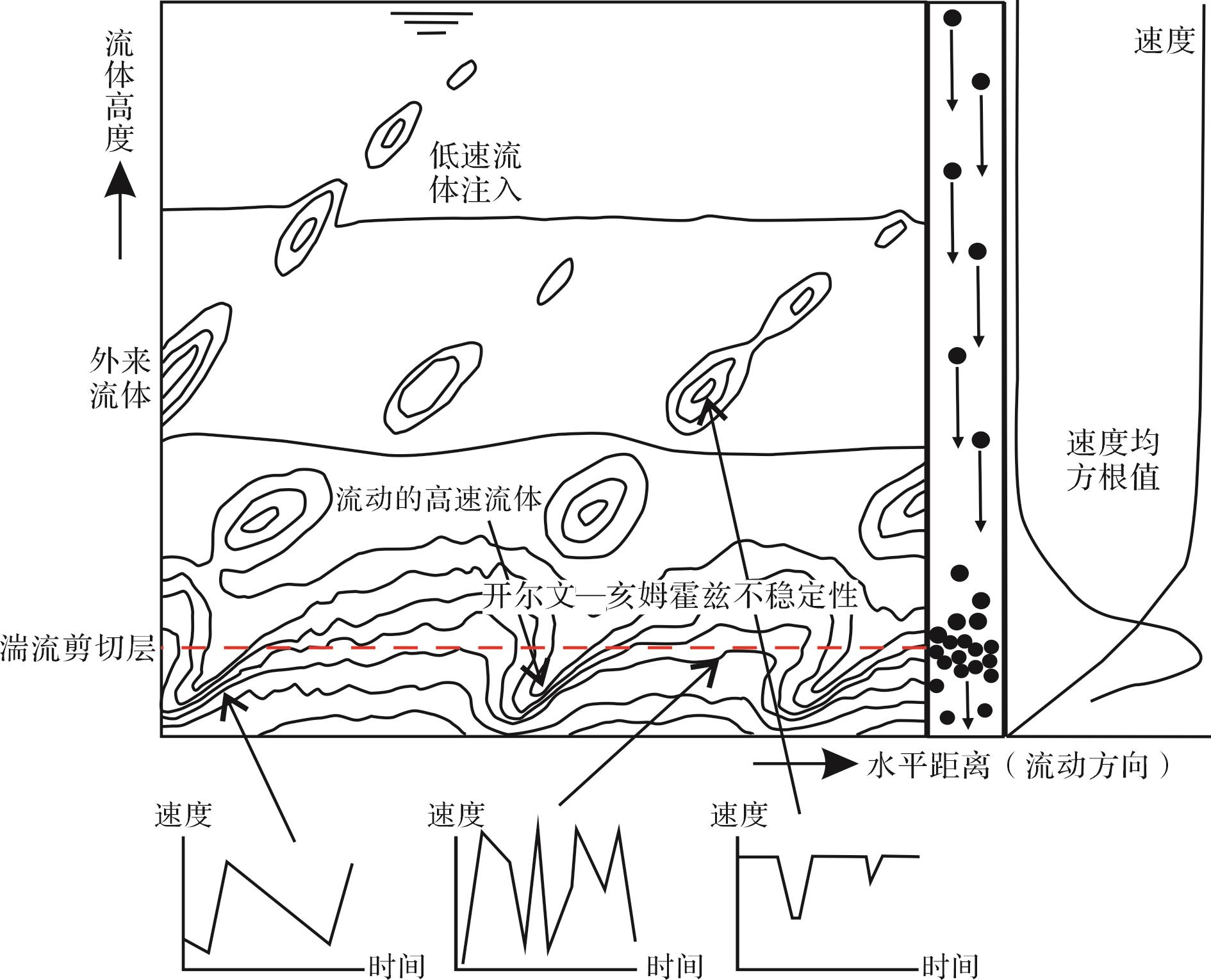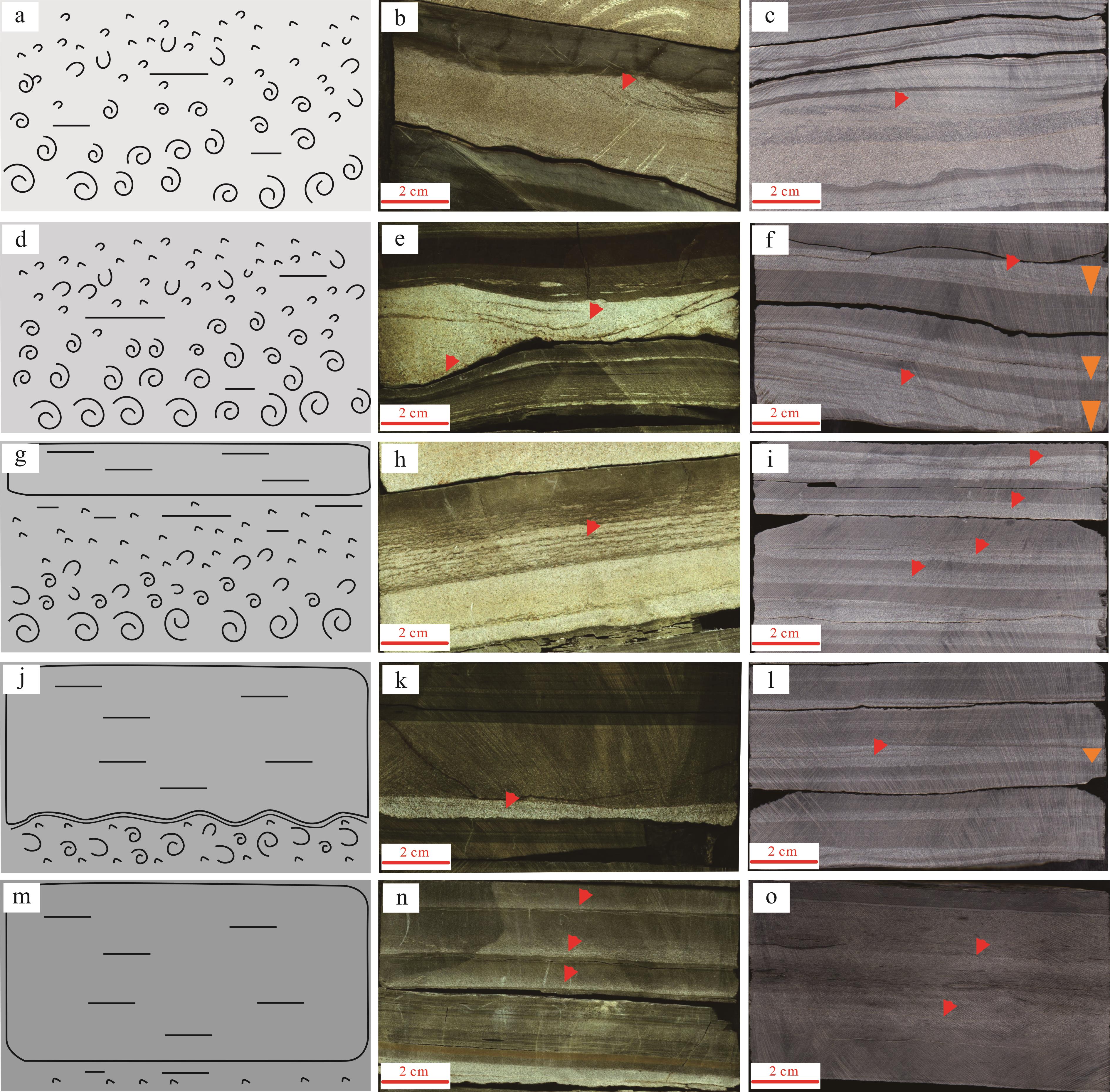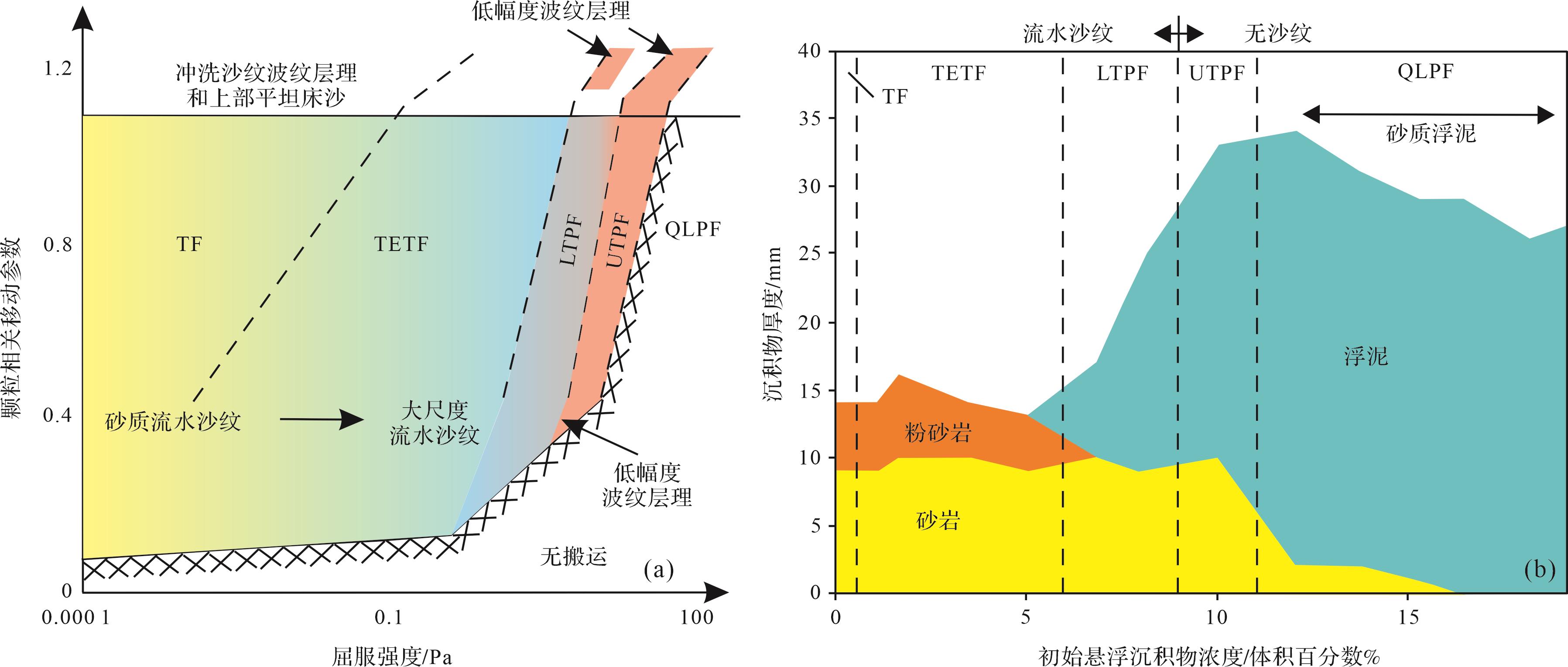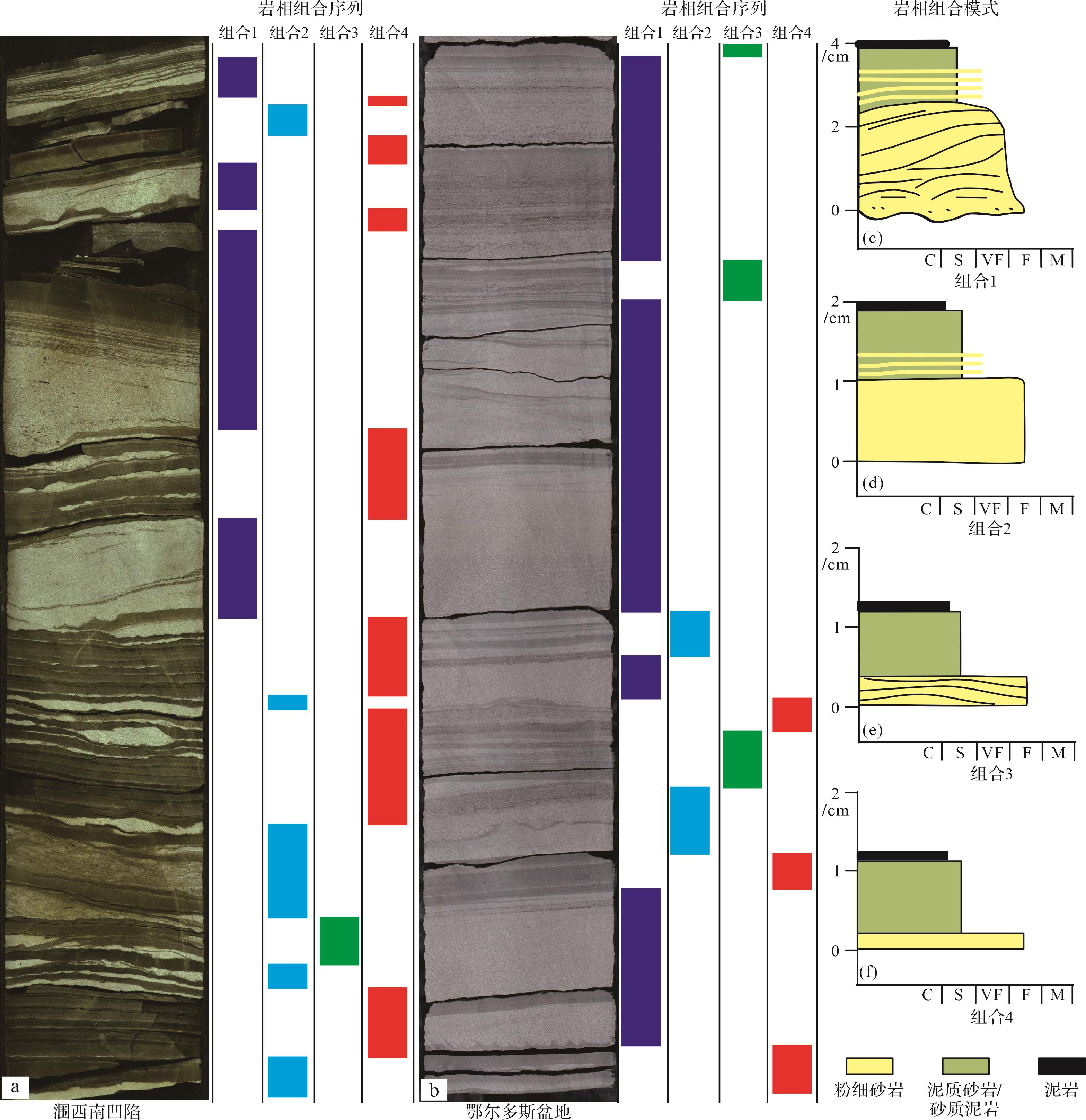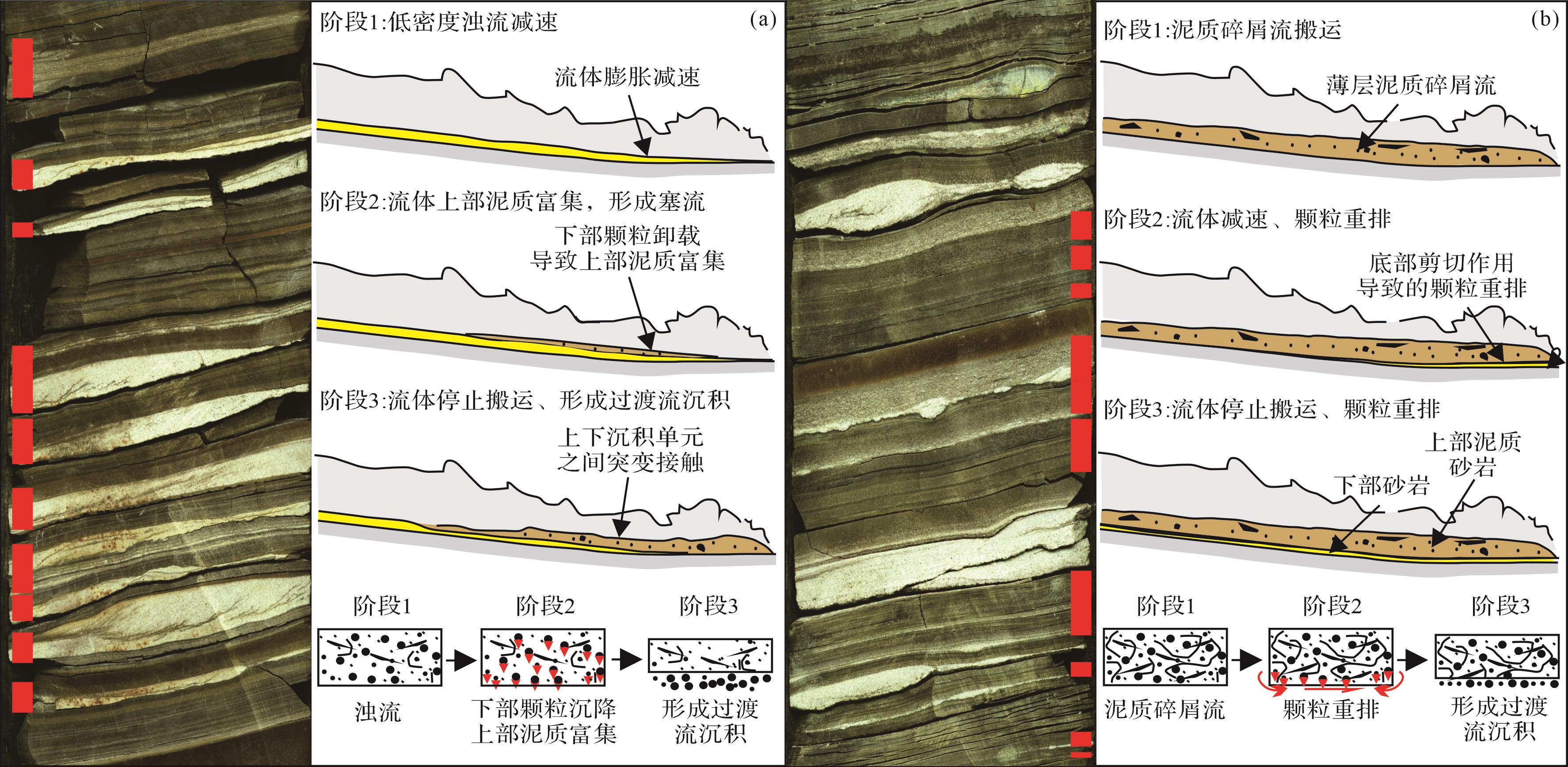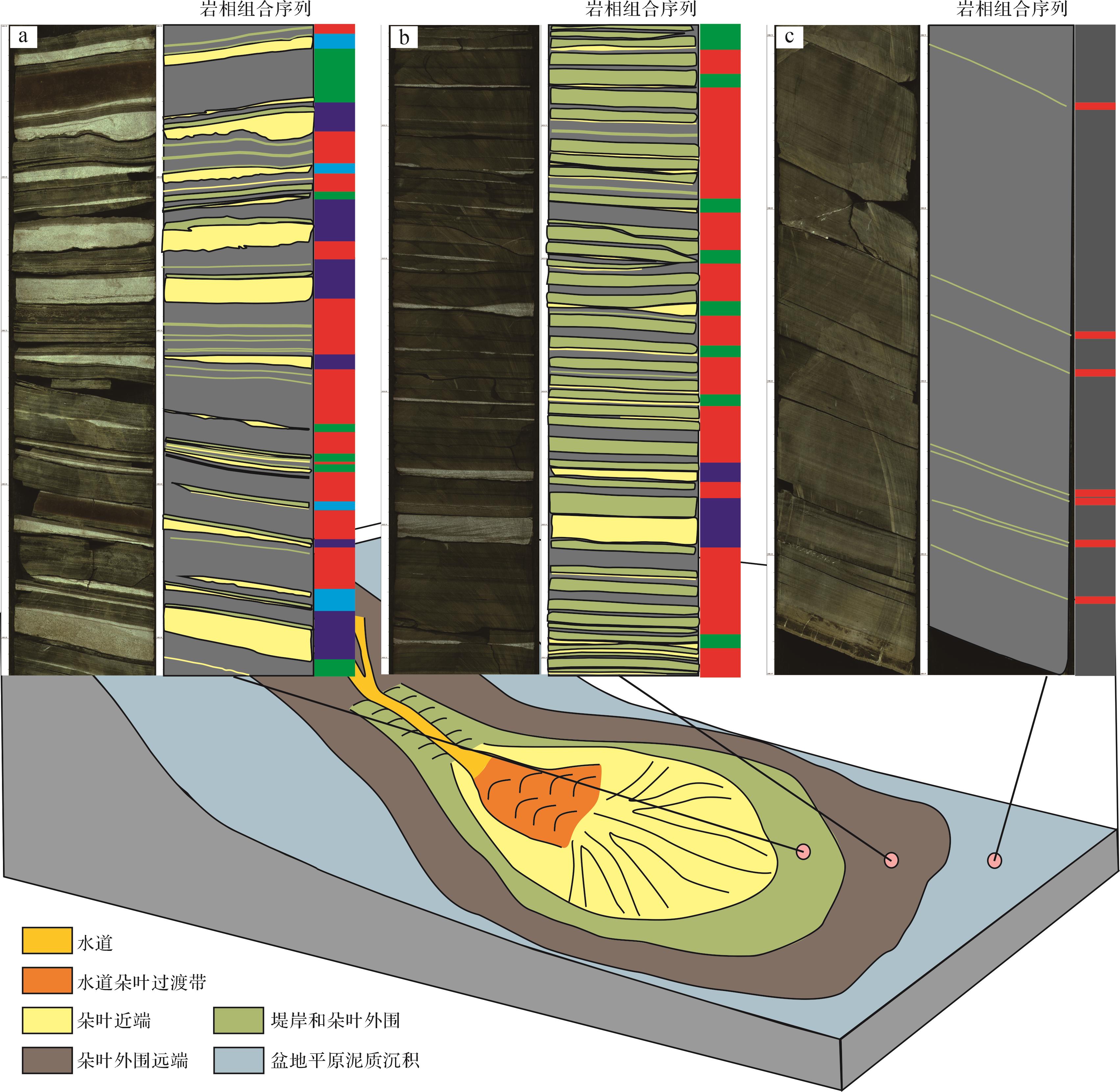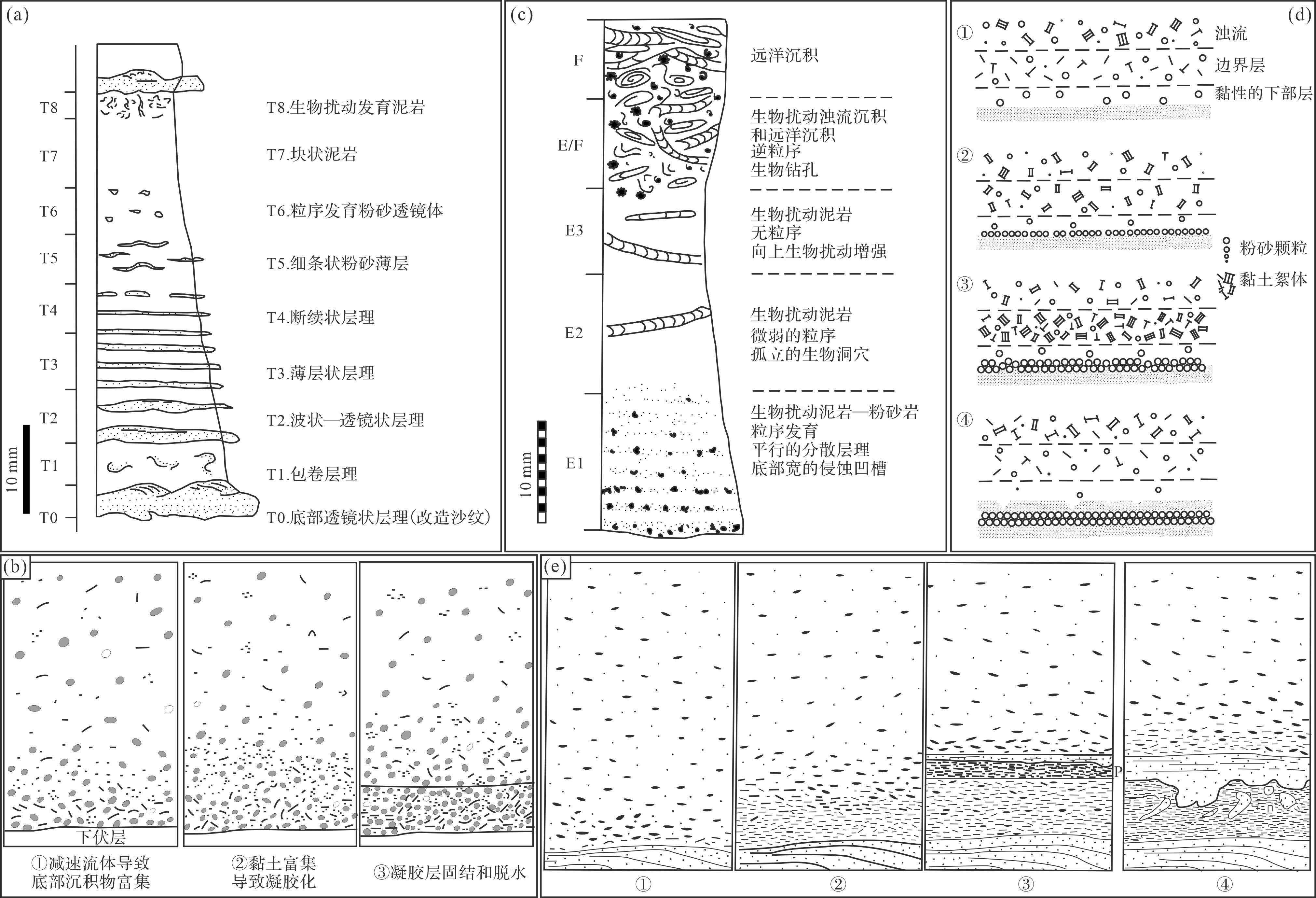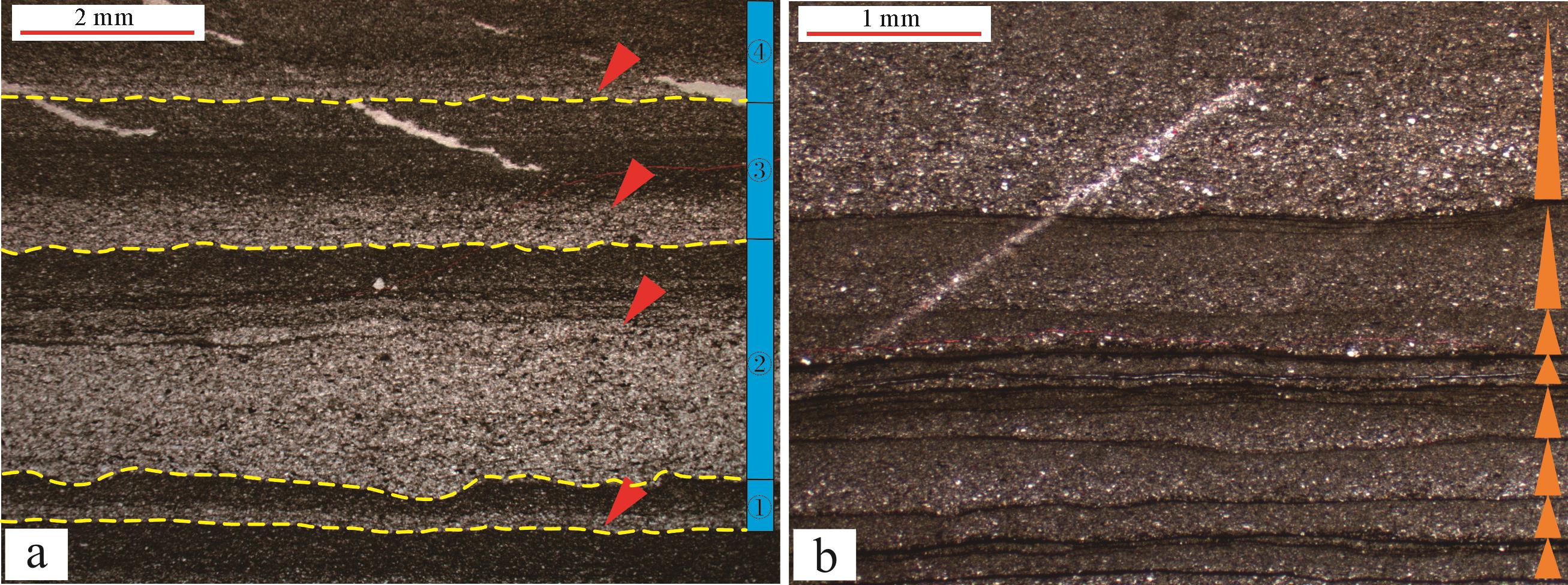HTML
-
细粒沉积物是指粒径小于62.5 μm的黏土级和粉砂级沉积物,分布广泛,约占全球沉积岩的三分之二[1⁃4]。研究细粒沉积物的形成及分布对古环境恢复[3⁃6]、全球沉积物搬运[7⁃9]、稳定的碳循环过程[6,10]和油气资源的高效勘探[11⁃12]等意义重大。传统观点认为细粒沉积物主要通过悬浮沉降形式沉积于安静水体环境,对沉积动力及沉积环境研究意义甚微,因而忽略了对其沉积特征及成因的精细研究[3,9,13]。近期研究表明,细粒沉积物同样可以在较强水动力条件下沉积[2,14⁃15],特别是通过生物—化学作用形成的絮凝颗粒以底床载荷的搬运形式可向深水盆地搬运数千千米而沉积[8,16]。深水重力流作为沿斜坡向深水盆地输运沉积物的重要动力机制之一,成为目前深水细粒沉积物重要的沉积动力机制新认识[8⁃9,16⁃23]。由于细粒重力流富含黏土矿物和有机质,其搬运演化过程、沉积物特征及分布规律都与传统的粗粒重力流之间存在明显差异[9,19,21,24⁃29]。黏土矿物和有机质的发育能够有效增强流体的内聚力,使沉积远端的低浓度细粒浊流的流体湍动受到抑制,逐渐转化为过渡流体(湍动增强过渡流、下部过渡塞流、上部过渡塞流),并最终转化为低强度黏性碎屑流(泥质碎屑流)[19,21,24⁃29]。部分学者将重力流过渡流体沉积等同于混合事件层沉积[30⁃31],最新的研究认为重力流过渡流体沉积与混合事件层之间存在显著差异,主要发育在朵叶沉积远端,以薄层砂泥互层为典型特征[32]。
低密度浊流沉积、过渡流沉积、泥质碎屑流沉积共存是沉积远端薄层砂泥互层型深水细粒重力流沉积物的重要表现形式[24⁃29]。这种与传统细粒沉积物成因及分布规律相悖的认识,是控制细粒沉积物沉积非均质性及有机质富集分布的重要原因[26,29],对非常规油气勘探开发意义重大[33]。湖盆细粒沉积物广泛发育,且富含黏土矿物与有机质,是过渡流沉积发育的有利场所;前期研究发现在东营凹陷沙河街组(图1a)、山东灵山岛地区下白垩统莱阳群灵山岛组(图1b)、涠西南凹陷流沙港组(图1c)、鄂尔多斯盆地延长组(图1d)均存在以条带状砂泥频繁互层沉积为主要表现形式的过渡流沉积[34]。为了加深对湖盆过渡流沉积的理解与认识,以涠西南凹陷流沙港组和鄂尔多斯盆地延长组为主要研究对象,对湖盆深水过渡流沉积特征、沉积过程及沉积模式开展系统研究,以期丰富和完善湖盆深水细粒沉积学理论体系,为细粒非常规油气勘探与开发提供新的视角。
-
涠西南凹陷位于北部湾盆地北部,是中国南海北部大陆架西部的一个重要的富油气凹陷。凹陷东南缘与企西隆起相接,西北缘为涠西南断层,西南缘与海中凹陷相邻,中间被涠西南低凸起相隔[35](图2a)。古近纪时期,涠西南凹陷为典型的陆相断陷盆地,受北东东—南西西向的系列大断层控制,形成北陡南缓、北断南超的构造格局,地层自下而上依次为长流组、流沙港组、涠洲组[36]。流沙港组自下而上可以进一步细分为流三段、流二段和流一段。其中,流一段沉积时期构造活动强烈,形成了大量的薄层砂泥互层型深水细粒重力流沉积(图2a),并且浊流与泥质碎屑流之间的过渡流沉积发育。
-
鄂尔多斯盆地是中国的第二大含油气盆地,横跨陕、甘、宁、蒙及晋,构造区划分为西缘冲断带、天环坳陷、伊陕斜坡、晋西挠褶带、伊盟隆起和渭北隆起六个单元[37]。晚三叠世延长组沉积时期,华北陆块和扬子板块相撞,受秦岭造山活动影响,发育一套大型坳陷盆地背景下的河流—三角洲—湖泊相碎屑岩沉积[38]。延长组沉积自上而下可划分为10个油层组(长1—长10),其中,长7油层组沉积期为最大湖泛期,湖盆水体深度大、水域面积广,发育一套富有机质泥页岩及三角洲—重力流的细粒砂岩沉积(图2b),薄层砂泥互层型细粒重力流沉积广泛分布,且浊流与泥质碎屑流之间的过渡流沉积发育。
1.1. 涠西南凹陷
1.2. 鄂尔多斯盆地
-
通过对涠西南凹陷和鄂尔多斯盆地发育的薄层砂泥互层型细粒重力流沉积特征对比分析(图3),发现沉积特征及成因存在相似性,发育的主要细粒重力流沉积包含泥质碎屑流沉积、砂质碎屑流沉积、低密度浊流沉积和过渡流沉积(图3a,e)。泥质碎屑流和砂质碎屑流沉积以薄层块状为主要特征(图3b,f),单层厚度多小于5 cm,与顶部和底部泥岩之间呈突变接触,指示了整体塑性块状固结的特征[16];泥质碎屑流沉积中泥质杂基含量较高、漂浮状砂球和泥质碎屑发育(图3b);砂质碎屑流沉积以顶部漂浮泥质碎屑发育为典型特征(图3f)。低密度浊流沉积以薄层正粒序沉积为典型特征(图3c,g),单层厚度多小于2 cm,粒序底部偶见微弱的侵蚀作用(图3c),垂向上以多层垂向叠置为主要特征(图3c),局部发育少量被悬浮沉积泥岩所分割的单层薄层正粒序沉积(图3g)。除了泥质碎屑流沉积与低密度浊流沉积之外,还可见与低密度浊流沉积或泥质碎屑流沉积密切伴生的(图3d,h),以条带状砂岩与泥岩频繁互层为典型特征的沉积产物(图3d,h);其下部砂质沉积多为块状,内部不显粒序或显示微弱的正粒序,上部泥质砂岩或砂质泥岩沉积整体呈块状,内部杂基含量较高,偶见漂浮的泥质碎片;下部与上部单元多突变接触,并且垂向上频繁互层叠加,指示相对稳定的沉积动力环境。该沉积物为典型的深水浊流与泥质碎屑流之间的过渡流沉积[25,39]。
-
重力流过渡流体(transitional flow)指流体从高雷诺数流体(浊流)变为低雷诺数流体(碎屑流)或者从低雷诺数变流体成高雷诺数流体时产生湍流构造的流体,包括位于浊流与泥质碎屑流之间的湍动增强过渡流、下部过渡塞流、上部过渡塞流三种过渡流体类型[24]。
湍动增强过渡流的流体湍动较浊流整体增强,流体搬运过程中底部的剪切层与基底剪切作用由于存在开尔文—亥姆霍兹不稳定性效应(Kelvin⁃Helmholtz Instabilities),产生旋涡并进入上部流体,从而导致流体整体湍动的增强[24,40](图4)。

Figure 4. Origin, distribution and evolution of turbulence in transitional gravity flow [24]
下部过渡塞流黏土杂基含量较湍动增强过渡流进一步增加,流体湍动受到抑制,上界面由于受剪切作用影响较弱而形成塞流,并逐渐向下扩展;下部受底部剪切作用与开尔文—亥姆霍兹不稳定性效应影响(图4),流体湍动增强,整体形成下部过渡塞流[24,40]。
上部过渡塞流是介于下部过渡塞流和准层状塞流之间的流体,由于杂基含量进一步增加,其上部塞流的厚度较下部过渡塞流明显增大,底部存在微弱的剪切作用,并且剪切层的位置较下部过渡塞流向上移动(图4),整体形成上部过渡塞流[24,40]。
-
过渡流体由于与浊流和泥质碎屑流的沉积动力机制存在显著差异,因而其形成的沉积物物质组成与沉积构造之间也存在显著的差异[25,40⁃41](图5,6)。
研究区浊流沉积(低密度浊流)以粉细砂岩沉积为主。由于其流体湍动具有由下至上逐渐减弱的特征(图5a),形成整体正粒序特征显著沉积序列(图5b,c),整体厚度多分布在5~10 cm,构成不完整的鲍马序列。其底部与下伏泥岩之间多呈轻微冲刷接触,指示流体具有一定的侵蚀能力,底部向上可发育微弱的平行层理(图5b),顶部沙纹层理发育(图5b,c),沙波高度多小于2 cm,波长多小于10 cm,迎流面倾角缓,背流面倾角陡,最大可达30°(图5b)。
湍动增强过渡流由于流体湍动较低密度浊流增强,导致流体整体的侵蚀能力和搬运能力较低密度浊流增强(图5d),从而多形成大尺度沙纹(图6a)[25,40]。主要表现在沙波的波高和波长较浊流沉积和正常单向流水形成的沙纹显著地增大,波高多大于2 cm,波长多大于10 cm(图5e,f)。同时,由于流体的侵蚀能力增强,局部会形成明显的下切(图5e);大尺度沙纹由于局部的砂质富集与下伏泥岩可形成局部的重力负载构造(图5e)。此外,沙波的波谷多被泥质或粉砂质充填,向上游方向过渡为砂质沉积(图5e,f)[25,41]。由于湍动增强过渡流以剪切面上部湍流增强最为显著,因而形成的大尺度的沙纹沉积多显示向上沉积物粒度变粗、泥质含量减小的逆粒序特征(图5f)。
下部过渡塞流以底部流体湍动增强,顶部流体湍动受到抑制为典型的流体结构(图5g),其沉积物以典型的上部泥质砂岩沉积与下部砂质沉积组合为特征(图5h,i、图6b)。由于顶部塞流段厚度较薄,其沉积形成的泥质砂岩沉积厚度相对较薄,厚度多小于1 cm(图5h,i);底部由于流体湍动增强,可形成块状或正粒序薄层砂岩沉积,厚度多小于2 cm(图5h)。顶部塞流沉积与底部湍流增强流体沉积之间,由于两种流体之间的相互作用,多形成薄层状砂质与泥质明暗相间条带叠置构造(图5h)。在底部流体湍动增强特征不显著情况下,则形成下部砂质与泥质明暗相间条带上部被薄层泥质砂岩覆盖的现象(图5i);下部砂质与泥质明暗相间条带内部可发育纹层或整体发生弯曲,较正常单向流水沙纹前积特征不显著,形成类似大尺度沙纹层理或低幅波纹层理(图5i)。
上部过渡塞流中上部为流体湍动受到抑制的塞流段,底部并未发生明显剪切,剪切层的位置较下部过渡塞流向上移动(图5j),其沉积物结构与下部过渡塞流沉积类似,为明显的上部泥质砂岩沉积与下部砂质沉积组合,上下沉积单元之间为明显的突变接触(图5k,l、图6b)。由于上部过渡塞流的塞流段厚度较下部过渡塞流明显增大,因而其上部形成的泥质砂岩沉积对应增厚,多大于1 cm,底部的砂质沉积厚度多小于1 cm(图5k,l)。此外,下部的砂质沉积内部可发育低幅波纹层理,这些波纹以波高小于1 cm,波长远大于10 cm为典型特征,与正常单向流水沙纹显示正粒序特征不同,该类低幅波纹层理显示逆粒序沉积特征(图5k,l、图6a)[25,41]。
准层状塞流(泥质碎屑流)为黏土杂基含量进一步升高,流体湍动被完全抑制的流体,仅在流体的最底部由于搬运过程中的剪切作用,存在微弱的流体湍动(图5m)。整体以块状泥质砂岩沉积为主要特征(图5m,o、图6b),在底部存在微弱剪切作用情况下,可发育微弱的砂质沉积,砂质沉积与上部泥质砂岩沉积之间多为突变接触关系,砂质沉积厚度多小于0.5 cm(图5m)。
-
重力流过渡流体是介于低密度浊流与泥质碎屑流之间的连续流体类型[24,27],因而,在搬运演化过程中不同流体类型并非孤立发育,不同流体类型之间往往规律组合,形成丰富的岩相组合序列[19,24,27]。
通过对涠西南凹陷流沙港组一段和鄂尔多斯盆地延长组长7油层组发育的典型深水细粒重力流沉积岩心的岩相组合类型精细解析(图7a,b),发现低密度浊流与泥质碎屑流及其之间的过渡流体沉积主要存在4种典型的岩相组合类型(图7c~f)。岩相组合类型1厚度最大,多大于4 cm,以下部砂质沉积和上部泥质砂岩或砂质泥岩沉积组合为典型特征(图7c)。下部砂质沉积底部可见明显侵蚀,上部沙纹层理和大尺度沙纹层理发育;砂质沉积上部可见薄层砂质沉积与泥质沉积互层叠置,向上过渡为块状泥质砂岩或砂质泥岩沉积。这种岩相组合序列多指示下部低密度浊流沉积或湍动增强过渡流与上部的下部过渡塞流沉积在垂向上的组合关系[19,24,27]。

Figure 7. Types and characteristics of sedimentary sequences of transitional flow deposits in lacustrine basins (legend as for Fig.1)
岩相组合类型2厚度主要为1~4 cm,平均厚度约2 cm,以下部砂质沉积与上部泥质砂岩或砂质泥岩组合为典型特征,上部与下部沉积单元厚度接近或下部沉积单元厚度略大于上部沉积单元(图7c)。下部砂质沉积以块状砂岩为主,可见微弱的侵蚀作用(图7a),上下沉积单元之间多为突变接触,上部沉积单元泥质与炭质碎屑富集(图7b)。这种岩相组合序列多指示下部过渡塞流沉积产物,该岩相组合序列易在垂向上叠置,形成单层厚度较大的砂质与泥质砂岩条带互层(图7a,b),指示存在下部过渡塞流稳定发育的沉积动力条件[39,42]。
岩相组合类型3厚度主要为0.5~2 cm,平均厚度约1 cm,以下部砂质沉积与上部泥质砂岩或砂质泥岩组合为典型特征,下部沉积单元厚度明显小于上部沉积单元,下部沉积单元内部发育低幅波纹层理(图7e)。这种岩相组合序列多指示上部过渡塞流沉积产物[19,41],该岩相组合序列同样易在垂向上叠置,形成厚度较大的砂质与泥质砂岩条带互层,但该类型条带互层结构的单层厚度较岩相组合类型2明显减薄(图7a,b)。
岩相组合类型4厚度主要为0.5~2 cm,平均厚度约1 cm,整体以泥质砂岩或砂质泥岩沉积为主,在底部可发育厚度小于0.5 cm的极薄层砂质沉积(图7f),为准层状塞流沉积产物[19,41],垂向上叠置可形成较大厚度。
涠西南凹陷流沙港组一段的细粒重力流沉积以岩相组合类型1和岩相组合类型4最为发育,鄂尔多斯盆地延长组长7油层组的细粒重力流沉积相组合类型2和岩相组合类型3更为常见,这种差异可能与不同盆地类型细粒重力流的流体差异演化过程存在密切的联系[19]。
3.1. 重力流过渡流体相关概念
3.2. 重力流过渡流体沉积特征
3.3. 重力流过渡流体沉积序列
-
水槽实验证实重力流过渡流体的形成演化过程主要受流体中黏性泥质杂基含量的控制,随着泥质含量的不断增加,流体逐渐从浊流演化为过渡流体,最终形成泥质碎屑流[24⁃27,40,43]。然而,在流体搬运演化过程中,泥质含量的增加机制仍然存在较多的争议[27,40⁃41],主要包括流体侵蚀下伏泥质基底导致流体中泥质含量的增加[39]和流体中砂质颗粒的优先沉降导致上部流体泥质富集[27]两种认识,前者强调流体的纵向搬运导致流体演化,后者强调碎屑颗粒的差异沉降过程导致流体演化[30,40⁃41]。
通过对研究区细粒重力流沉积特征和类型的系统研究,认为不同的物质组成与沉积构造对应不同的沉积过程[44⁃46]。研究区的过渡流体沉积包括纵向搬运演化与垂向物质分异两种差异显著的成因类型(图8)。湖盆过渡流沉积中,岩相组合类型1和岩相组合类型2的发育指示其为流体纵向搬运演化形成。低密度浊流局部侵蚀泥质基底,导致流体中泥质含量增加;低密度浊流在演化的晚期由于膨胀减速,砂质颗粒卸载后流体上部泥质含量进一步增加,从而演化为湍动增强过渡流或下部过渡塞流(图8a)。该演化过程形成的过渡流体沉积底部砂质沉积厚度明显大于上部泥质砂岩或砂质泥岩沉积单元厚度,且下部砂质沉积单元底部可见微弱侵蚀,同时沙纹发育,指示明显的纵向底负载搬运过程(图8a)[25,39]。岩相组合类型3和岩相组合类型4的发育指示其为垂向碎屑颗粒差异沉降过程形成,多为泥质碎屑流搬运晚期底部剪切形成的上部过渡塞流导致底部砂质沉积富集,或泥质碎屑流停止搬运后,内部碎屑颗粒发生重排,砂质颗粒在自身重力作用下向底部沉降富集,而泥质杂基在顶部相对富集,这种差异沉降卸载形成双层结构(图8b)。该种差异卸载过程形成的过渡流体沉积底部砂质沉积厚度明显小于上部泥质砂岩或砂质泥岩沉积单元厚度,砂质沉积单元顶底部以突变接触最为常见,偶见微弱的沙纹发育,指示明显的垂向差异卸载过程(图8b)[27,47]。
-
在湖盆重力流过渡流体沉积特征及沉积过程研究的基础上,进一步对涠西南凹陷流沙港组一段细粒重力流沉积分布特征进行分析,重点选取重力流过渡流体沉积发育的3口典型取心井W11-7-4、WZ11-7N-2井和W11-7-2井(图2b)。从分布位置来看,W11-7-4井位于沉积物搬运中心位置的前方,WZ11-7N-2井和W11-7-2井则位于重力流砂体分布的边缘,不同分布位置发育的重力流过渡沉积类型存在显著差异(图9)。

Figure 9. Distribution model and formation mechanisms of transitional flow deposits in lacustrine basins (for legend of lithofacies association see Fig.7)
W11-7-4井位于沉积物搬运中心位置的前方,以泥质沉积与砂质沉积互层为典型特征(图9a),砂质沉积除发育部分低密度浊流形成的薄层砂体之外,湍动增强过渡流沉积形成的岩相组合类型1和下部过渡塞流沉积发育形成的岩相组合类型2发育(图9a)。这种沉积组合特征指示紧邻沉积物搬运中心位置,在低密度浊流发育背景下,其向前搬运演化控制形成的湍动增强过渡流和下部过渡塞流沉积同样发育[41]。随着向沉积远端搬运距离的增加,砂质沉积逐渐减少,泥质沉积不断增加,整体以泥质砂岩或砂质泥岩沉积为主,内部夹少量的薄层砂条,形成类似WZ11-7N-2井以上部过渡塞流沉积和泥质碎屑流沉积为主的岩相组合类型3和岩相组合类型4,偶见岩相组合类型1和岩相组合类型2(图9b)。这种沉积组合特征指示随着搬运距离增加,流体纵向搬运分异能力逐渐减弱,碎屑颗粒的垂向差异沉降卸载过程控制了砂泥沉积物的分异。在重力流沉积的最外围以泥质沉积为主,砂质沉积基本不发育,形成类似WZ11-7N-2井以悬浮泥质沉积为主的沉积组合,偶见泥质碎屑流沉积形成的岩相组合类型4(图9c)。这种沉积特征指示重力流沉积对该区的影响已经十分微弱,仅有少量泥质碎屑流沉积。
综上,湖盆中重力流过渡流体沉积形成的细粒沉积物主要分布在相对粗粒砂质沉积的前缘,紧邻粗粒砂质沉积以细粒低密度浊流沉积和湍动增强过渡流沉积、下部过渡塞流沉积为主,整体形成砂泥互层的沉积特征,砂质沉积中沙纹和大尺度沙纹沉积构造发育。随着砂质沉积物的不断沉积和向沉积远端的进一步搬运,流体湍动进一步受到抑制逐渐转化为上部过渡塞流和泥质碎屑流,整体形成以泥质沉积为主的沉积特征,局部发育薄层、低幅波纹层理的砂质沉积。流体纵向搬运分异与垂向差异卸载过程是控制不同位置流体类型及沉积特征差异的主要原因[41]。
4.1. 重力流过渡流体沉积过程
4.2. 重力流过渡流体沉积模式
-
细粒沉积物的沉积过程是沉积学研究中的公认难题[3⁃4,8,48⁃49],特别是细粒沉积物的薄层砂质沉积与泥质沉积频繁互层的成因长期困扰沉积学界[9,31,39,41,50]。针对细粒沉积物中的频繁互层成因主要包含外部控制因素作用成因[13]和沉积动力分异成因两种解释[42,50],即对应异旋回和自旋回两种控制作用。此外,机械压实作用和化学成岩作用也可能是这种互层组构的成因解释[8,51]。
外部控制因素主要强调流体的能量变化导致搬运的沉积物粒径的变化,从而形成砂质与泥质沉积物的垂向叠加,如低密度浊流沉积过程中同样存在能量强弱的波动变化,能量较强时以搬运砂质沉积物为主,能量减弱时则以搬运泥质沉积物为主,最终形成砂泥互层的沉积组构(图10a)[13]。同时,不同重力流事件沉积在垂向上的叠加也可能是这种砂泥互层沉积组构的成因机制解释,单一重力流事件沉积在沉积早期以砂质沉积为主,沉积晚期能量减弱形成泥质沉积(图10b)[51];或者重力流事件沉积期以砂质沉积为主,事件间歇期以悬浮沉降形成的泥质沉积为主(图10c)[4],不同的重力流事件沉积在垂向上的重复叠置形成砂质沉积与泥质沉积频繁互层的沉积组构。

Figure 10. Formation mechanisms of frequent alternation of thin⁃bedded sandstone and muddy sandstone or sandy mudstone in fine⁃grained sediments
沉积动力分异成因解释则强调砂、泥混杂的细粒沉积物在搬运过程中,流体与基底的剪切作用会导致黏土絮凝结构遭到破坏,砂质沉积在底部聚集,同时大量悬浮的黏土在砂质沉积层上部重新聚集。当黏土含量达到一定浓度阈值时会发生整体聚集卸载,形成泥质沉积层[52];而后重复上述过程,形成频繁的纹层状砂泥互层沉积组构(图10d)[50],也称为沉积分选作用。Lowe et al.[42]进一步指出,这种沉积分选作用是形成纹层状至单层厚度数十厘米频繁砂泥互层沉积组构的主要原因。与单纯的黏土含量达到一定浓度阈值时会发生整体聚集卸载形成泥质沉积认识不同,Lowe et al.[42]认为黏土含量达到一定浓度阈值的黏性层不会直接卸载,而是形成隔层阻碍砂质颗粒的沉积。砂质颗粒的沉积积累会进一步压实下部黏性层,最终部分垮塌陷落到下部黏性层导致沉积物浓度增加,整体固结形成泥质沉积层及下部暗色泥质沉积和上部砂质沉积的双层结构。之后重复上述过程,形成频繁的砂质与泥质沉积互层(图10e)。在这种情况下,黏土矿物类型与含量、有机质类型与含量、碎屑颗粒粒径及密度等因素,可能是控制这种互层沉积中单层厚度的重要因素[25⁃26,29,31,42]。
重力流过渡流体沉积形成的砂泥频繁互层沉积组构同样是沉积动力分异控制下的沉积产物,即泥质杂基、有机质类型和富集是控制过渡流体转化进而形成砂泥互层沉积组构的主要原因[25⁃26,29,41]。同时,下部过渡塞流沉积与泥质碎屑流沉积形成的砂泥互层沉积指示了早期形成泥质杂基为主的沉积物,而后期内部碎屑颗粒差异沉降卸载形成下部砂质沉积上部泥质沉积的沉积分异过程[27,47]。这种认识与传统认为的沉积物从下至上逐渐叠加沉积过程截然相反,进一步丰富了对细粒沉积物形成过程的认知。
-
通过细粒沉积物的沉积地球化学分析恢复其形成的古环境,进而探究古环境的演化是沉积学的重要研究内容[53]。特别是具有砂泥频繁互层沉积组构的细粒沉积物,过去研究多认为其形成受季节变化、天文旋回乃至重大地质事件的控制[33],是反演上述地质信息的良好载体。如上文所述,如果发育砂泥频繁互层沉积组构的细粒沉积物沉积过程主要受外部控制因素的控制,这种互层组构无疑会忠实地记录对应控制因素对沉积过程的控制作用,通过对不同物质组成沉积物的沉积地球化学分析,可以准确地反演地质历史时期对应控制因素的变化情况[54],从而为古环境、古气候演化乃至重大地质事件的恢复提供准确的信息。然而,若发育砂泥频繁互层沉积组构的细粒沉积物沉积过程主要受内部沉积分异过程的控制,盲目地采用沉积地球化学分析将砂泥互层组构完全归因于沉积环境的演化,可能造成沉积信息的误读。因此,针对砂泥频繁互层沉积组构发育的细粒沉积物开展沉积地球化学分析时,细粒沉积物的沉积过程分析意义重大。
-
湖盆细粒沉积物中有机质和黏土矿物富集,是控制重力流过渡流体发育的重要因素[25,29]。一方面,重力流在搬运过程中与泥质基底相互作用,使得在湖盆边缘沉积的有机质进一步向深水盆地搬运,从而控制了深水区有机质的富集[19,29],如宋红盆地中的重力流过渡流体沉积有机质含量丰富,平均为2.88%[19];另一方面,重力流的扰动促进了黏土矿物与有机质的相互作用,形成有机黏土复合体。这种复合体较单纯有机质的抗降解与氧化能力更强,从而有利于有机质的保存和富集[55]。同时,黏土矿物、有机质、有机黏土复合体的发育促使浊流向过渡流体和泥质碎屑流转化,过渡流体和泥质碎屑流沉积物多以整体固结的形式沉积,较快的沉积速率降低了有机质氧化时间,利于有机质的有效保存[19,29]。因而,湖盆中重力流过渡流体沉积发育的区域可能是有机质富集的有利部位,对明确湖盆有机质富集规律具有重要意义。
-
湖盆中重力流过渡流体形成的砂质沉积与泥质沉积频繁互层沉积组构是潜在的页岩油气甜点发育区[34,56⁃57]。前文述及,黏土和有机质的发育是促进重力流过渡流体发育的主要因素,过渡流体沉积多形成下部砂质沉积、上部泥质沉积的双层结构(图11a)。这种下部砂质沉积上部泥质沉积的沉积组构较低密度浊流沉积形成的正粒序结构(图11b)具有有机质更为富集的特征[19,29]。其上部泥质沉积黏土和有机质富集,为油气的生成提供了物质基础;下部的砂质沉积紧邻上部泥质沉积,为上部生成的油气提供了潜在的储集空间(图11a)。同时,这种下部砂质沉积上部泥质沉积较纯泥质沉积具有易于压裂的优势,利于改造开发[57]。稳定的过渡流体沉积可以形成累计厚度数十米到上百米的砂泥频繁互层沉积组构,是页岩油气中的“甜点”区发育的优势沉积岩相组合类型。现阶段关于重力流过渡流体沉积与页岩油气富集之间的关系尚不明确,相关研究可为细粒非常规油气勘探开发提供新的思路。
5.1. 细粒沉积物沉积过程
5.2. 沉积物沉积环境恢复
5.3. 湖盆有机质富集规律
5.4. 非常规油气地质意义
-
(1) 湖盆湍动增强过渡流沉积以砂质沉积为主,大尺度沙纹层理发育,砂质沉积物向上粒度变粗;下部过渡塞流沉积以下部砂质沉积与上部泥质沉积近等厚为特征,中间多发育薄层状砂质与泥质明暗相间条带;上部过渡塞流沉积整体以泥质沉积为主,下部发育的反序薄层砂质沉积中可发育低幅波纹层理。
(2) 湖盆过渡流体沉积发育4种岩相组合模式,岩相组合类型1和岩相组合类型2下部砂质沉积单元厚度大于上部泥质沉积单元厚度,为湍动增强过渡流和下部过渡塞流沉积产物;岩相组合类型3和岩相组合类型4下部砂质沉积单元厚度小于上部泥质沉积单元厚度,为上部过渡塞流和准层状塞流沉积产物。
(3) 湖盆过渡流体沉积含侧向搬运演化与垂向物质分异两种差异显著的成因类型,前者紧邻相对粗粒砂质沉积,为低密度浊流在演化晚期由于膨胀减速,砂质颗粒卸载后流体上部泥质含量进一步增加,从而演化为湍动增强过渡流或下部过渡塞流沉积;后者主要发育于沉积远端,多为泥质碎屑流搬运晚期底部剪切形成的上部过渡塞流导致底部砂质沉积富集,或泥质碎屑流停止搬运后,内部碎屑颗粒发生重排导致底部砂质富集。
(4) 细粒重力流形成的砂泥频繁互层沉积组构受外部因素和内部沉积分异作用共同控制,在利用砂泥频繁互层沉积组构发育的细粒沉积物开展沉积地球化学分析时,需要先明确其沉积过程;湖盆中重力流过渡流体沉积发育的区域,可能是有机质富集的有利部位,也是潜在的页岩油气甜点发育区。

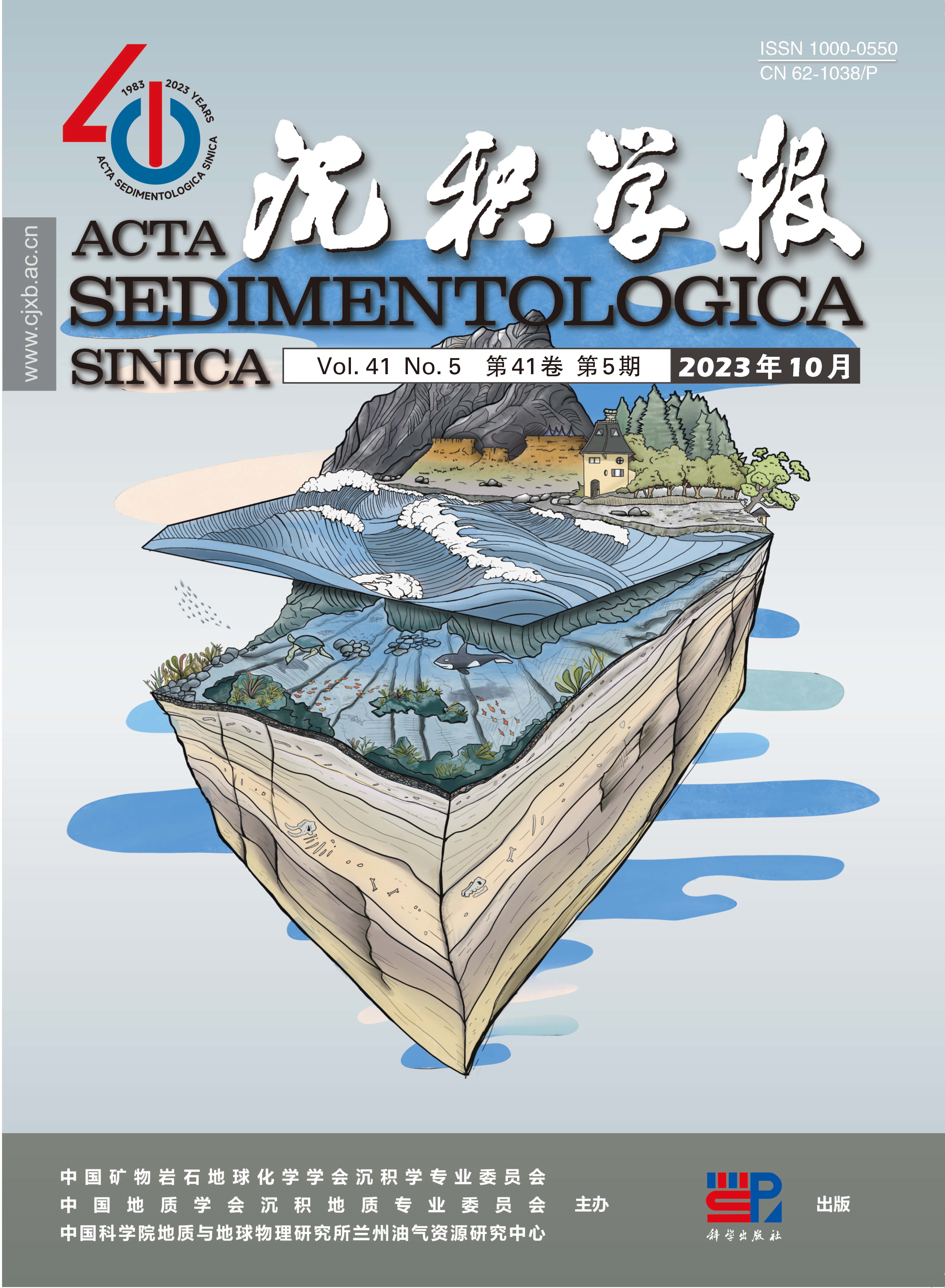


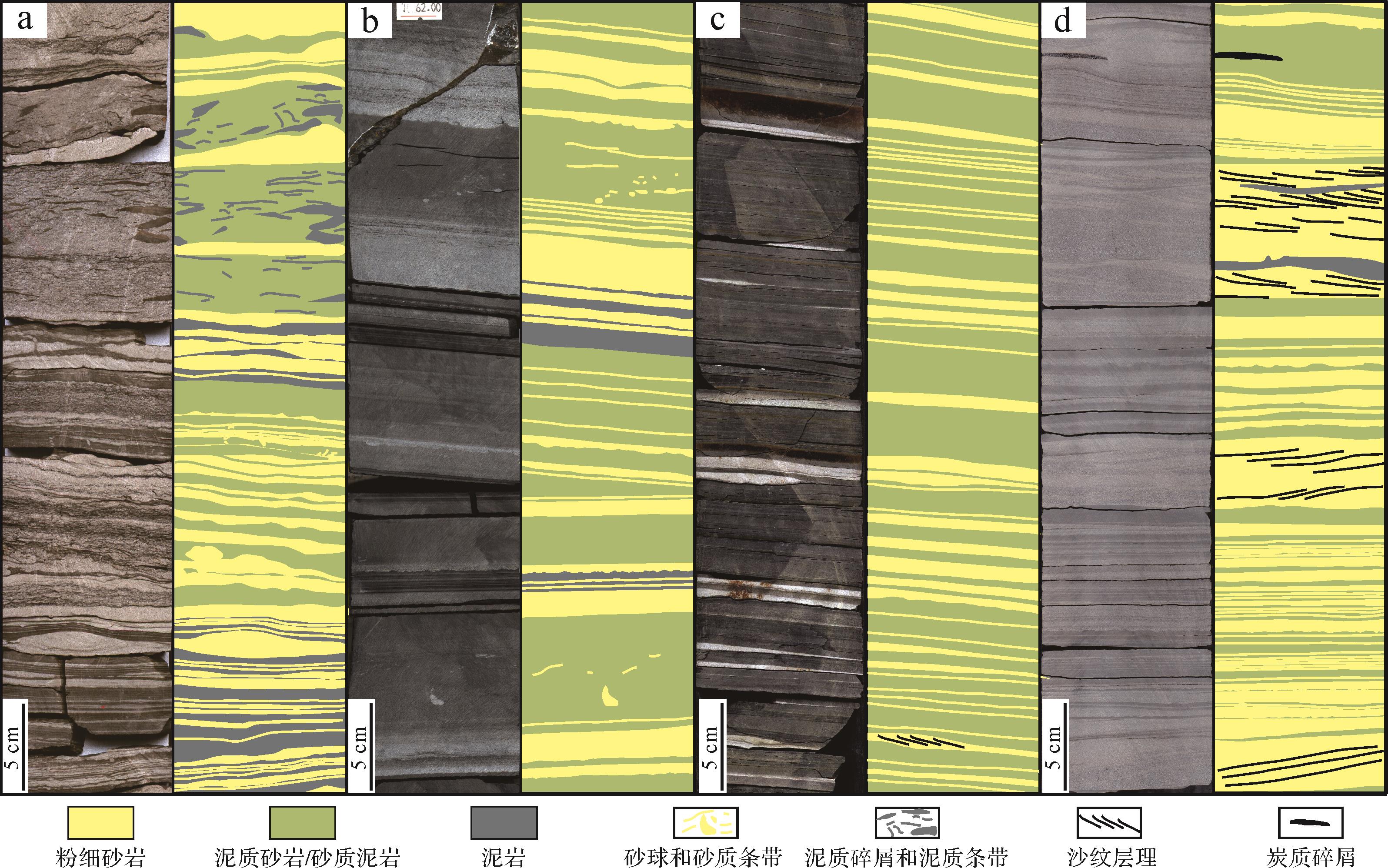









 DownLoad:
DownLoad:
